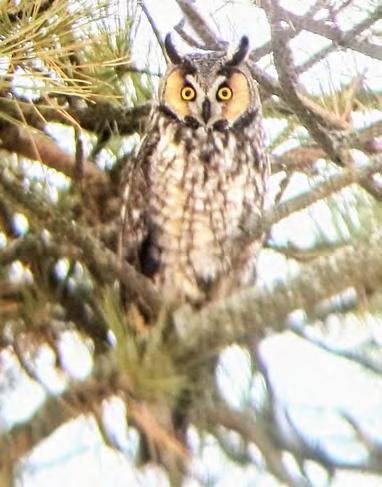
8 minute read
OWL FIND YOU
Enjoy watching these remarkable birds but respect their space By Sasan Beni
THIS YEAR, THANKS to a raging global pandemic, more and more people are turning to nature. The Great Backyard Bird Count in February saw a major increase in participants, many of whom were stuck at home in isolation, watching the bird feeders in their yards. Nature has an extraordinary ability to heal us, to calm us down, to bring us back to our quiet selves. Wildlife photography has become many people’s preferred pastime, myself included. It is a remarkable feeling to observe a wild animal in its natural environment, to record its movements, its unique character... but, this wonderful pastime also poses a challenge: in the pursuit of the perfect shot, we often disturb the wild animals we love so much. We try and get closer to them, which, in many instances puts them in harm’s way. This is, perhaps, most true in the case of owls.

GREAT HORNED OWLS are among the largest owls in North America. They are thick-bodied with two prominent feathered tufts on the head. Their call is a series of deep stuttering hoots.
Toronto is home to several species of owl. This past winter, I set out to find and photograph as many of the reclusive birds as I could. After about three years of frequent birdwatching, my only owl sightings had been the images shared on Facebook groups like Toronto Birding, or Ontario Birds. So many talented photographers, armed with heavy lenses, were finding owls on a regular basis, and in the flurry of incredible photographs posted online, one thing was often clear: most of these owls did not look happy. In fact, they looked stressed.
A disturbing pattern that I noticed on social media was when several photographers would share images on the same day, of the same bird, perched on the same branch, same lighting/time of day, same vexed glare. It was evident that groups of photographers were flocking to a location where someone had reported an owl sighting. Some photographers, no doubt, would stay there for hours, often provoking the bird to take flight, or to open its eyes if asleep, so they could take their dream shot.

THE LONG-EARED OWL is a medium sized species. They are cryptically marked which means they can blend into the background. They have long ear tufts and an orange face.
Masters of Camouflage
Most owl species are nocturnal. They spend their days hiding in tree cavities and dense forests. They are masters of camouflage for a reason, and we need to respect their space. This is why many birders keep their findings a secret or are vague in reporting the location of their beloved owls. I, too, feel their concern, but I like to share my sightings. The more I find, the more I like to share. The more I learn, the more I want to teach.
On December 29, 2020, I found my first owl, or, better to say, it found me. After about three hours of hiking in Tommy Thompson Park, I was ready to call it a day and head home, when suddenly, I came face-to-face with a sleepy Barred Owl in a birch tree, completely visible on all sides. I froze in my tracks and stood as erect as the thin pillars of horsetail grass that surrounded me on the narrow trail. My heart was beating something fierce—the flutter of butterflies in my stomach made the whole world quiet. I wondered how I hadn’t noticed it earlier; I’d made my way through the same lot of horsetails and dogwoods, past the same birch, an hour before! How long was it sleeping there? I adjusted my footing an inch closer. The Barred Owl cracked open its weary eyelids and glanced at me with its deep black eyes. I froze again and felt as if I was in the presence of an ancient forest deity, full of peace and understanding. Barred Owls have expanded their range in recent years. They are not uncommon in our region, but to find one like this was a real treat. I stood there for half-an-hour and watched the sleepy owl and did not get any closer. They say that a sleeping owl is a happy owl, and I was beyond grateful for the experience.

SNOWY OWLS native to the Arctic but found in southern Canada. Their thick feathers for insulation make them North America’s heaviest owl.at about four pounds. Photo: Luke Trotta
A few days later, I returned to Tommy Thompson Park, to the same forest of horsetail, dogwood and birch, this time with a friend. I recounted my sighting of the Barred Owl, its relaxed state, how I presumed that it must nest nearby. Naively, I somehow thought we would find it in the same birch tree, or further down the path, still asleep. It was no longer there, and we continued our walk through the horsetails as quietly as possible. It was not long before my friend noticed the silhouette of a bird of prey perched high-up in a tree on the edge of the woodlot. We raised our binoculars and both gasped. It was a Great Horned Owl. I had heard from other birders that there was a pair living at the park, that they were quite active and could even be heard calling to each other during the day. Unlike the Barred Owl I had seen a few days before, the Great Horned Owl was wide awake, surveying the area and completely aware of our presence like another type of ancient forest deity, full of rage and hunger, with sharp yellow eyes.
Great Horned Owls are among the largest in North America, with the most extensive range of habitat, from the tropical forests in South America to the frozen plains of the Arctic. They are highly adaptable and dominant predators. My friend and I were ecstatic, almost floating, as we moved closer to a small clearing and took a few photos of the incredible bird from about 70 metres away. I commented to my friend, “I love this park. It is something special.” I would be going back there frequently in the coming weeks.

THE BARRED OWL is named for the vertical brown bars on its chest. Young ones can climb trees by grasping the bark with their bill and talons and walking up the trunk.
Baby Steps
I updated my list and set my sights on the next owls I hoped to find—the Northern Saw-whet Owl (one of the smallest in North America) and the Snowy Owl that leaves the Arctic every winter and flies south to feed. And, of course, there are the Eastern Screech Owl, the Long-eared Owl, Short-eared Owl… My recent luck with finding these almost mythical birds was making me a bit over-confident that I would find every one of these species before winter’s end. “Baby steps,” I told myself.
On January 16, 2021 I decided to dedicate an entire day to Tommy Thompson Park. I mapped out the longest route, making sure to cover the entire park, to leave no stone unturned, no side-trail free of steps. I estimated it would take me five hours or so, but my plans changed about 30 minutes down the main path. I noticed a photographer sitting on the snow by a small patch of cedar trees, with his giant camera lens pointed at the dense conifers. I walked past him at first, even though I knew he was definitely looking at an owl, a Northern Sawwhet. I am always reluctant to approach other wildlife photographers. I don’t like to crowd a scene where an animal has been spotted and in the case of Saw-whet owls, this concern is amplified. Being such small birds of prey, they will be hunted by pretty much every other raptor. They are notoriously nocturnal and will spend all day hidden in evergreens. Their instinct is not to move, because leaving their hiding spot in broad daylight could put them in great danger.
Despite my inclination, I turned around and went back, approaching the photographer with slow and wellmannered steps. What followed was, to me, a great example of ethical owl watching, a neighbourly moment between two lovers of wildlife who believed in sharing, in approaching owls with kindness. He waved me over. “Saw-whet Owl,” he whispered and pointed halfway up the cedar. “I am done taking pictures,” he went on and quickly packed up his gear and offered me his spot. He was sitting on the ground, as low as possible, not only because that offered him a great view of the bird’s face, but also because it was less threatening. This owl, too, was completely asleep. I thanked him repeatedly for pointing it out to me and apologized just as much for having approached him. He didn’t mind at all, and said, “I noticed the binoculars around your neck. Us birders need to look out for each other,” he laughed and walked away.
Since then, I have taken a few friends, some birders, some not, to show them the small owl. And every time, their excitement takes me back to my first sighting, to my beating heart, to the flutter of butterflies in my gut. I have come to learn that witnessing these remarkable beings in our own backyards will inspire us to cherish our green spaces, to safeguard them. I am confident that education will lead to care. The more we know about the threats posed to owls, the more we will try to minimize them. “Us birders need to stick together,” but even more than that, we have a responsibility to share our passion with non-birders, to teach them about the vast biodiversity in our urban jungle. I want everyone to enjoy the experience of seeing these remarkable and reclusive birds, and to know that a photograph from upclose is almost never worth it. The more I find, the more I want to share. The more I learn, the more I want to teach.
— Sasan Beni is a seasonal gardener at the TBG and an avid bird watcher and photographer.









